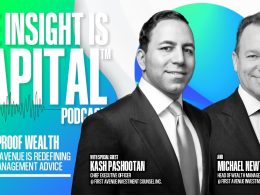Succession Planning for a Family Business
by Commonwealth Financial Network
 Today’s post continues our case study series, showcasing the many creative solutions you can take when you’ve landed clients with complex planning issues. Here, we’ll explore succession planning for a family business.
Today’s post continues our case study series, showcasing the many creative solutions you can take when you’ve landed clients with complex planning issues. Here, we’ll explore succession planning for a family business.
We introduced your new clients, the Thompsons, in a previous post. As the focus of this discussion is succession planning, here’s what you need to know about the Thompson family business:
Ed and his brother, Bill, have grown the family business (Thompson Electric) into one of the premier contractors in the metro Boston area. Their father and uncle started the business 48 years ago, and they want to continue family ownership. The boom in commercial construction in the area in recent years has really benefited the business. They recently closed several very lucrative long-term commercial contracts, including one for a large casino complex being built in the region.
The brothers’ succession plan has always been to leave their shares in the business to each other. Currently, a cross-purchase buy-sell agreement is in place, allowing each brother to purchase the other’s shares from his estate. This arrangement is funded with permanent life insurance. There are also key man term life policies insuring each brother, with a remaining term of five years.
Bill. Since receiving some grim news about his health, Bill has shifted his focus from work to travel. His priorities include:
- A tax-efficient succession plan
- A short transition time frame (less than six months)
- Ongoing cash flow to fund his travel
- Continued success of the business
- Minimizing business disruption for clients and employees
- Taking care of key employees
- Leaving a legacy for Ed’s daughter, Katherine, and her daughters
Bill wants Ed’s sons, Ryan and Chase, to take over Thompson Electric, as they have been learning the business since they were kids. He sees his nephews as assets to the business but fears they may not be ready to assume control. He has seen businesses taken over by the next generation fail, and this is a big concern for him.
Ed. Ed is devastated by his brother’s poor health, and it’s forced him to reevaluate his priorities. Although he loves the family business, he’s ready to pursue his other passion in life: art. He wants to teach at the Museum of Fine Arts and simply enjoy life with Janice.
His succession priorities are very similar to Bill’s, except that he would like to transition from the business over the next couple of years, turning the day-to-day operations over to his sons, Ryan and Chase. But Ed wants to maintain the right to veto any decision he feels is not beneficial to the business. He also wants to leave a legacy for his daughter, Katherine, and grandchildren.
In reviewing possible solutions, two viable options emerge.
Transfer ownership of life insurance. One suggestion is to transfer ownership of the permanent life insurance policies from the brothers to their respective insureds. Further, gifting these policies to an irrevocable life insurance trust would remove them from the brothers’ estates. Each may name personal beneficiaries, which would address Ed’s desire to equalize the estate and benefit his daughter, Katherine, since she’s not a part of the family business.
Promissory note installment sale. Following discussions with his counsel, Bill is considering a promissory note installment sale to an intentionally defective grantor trust (IDGT). This type of trust would remove the business from his estate. Of course, the value of the unpaid note balance would remain in the estate should he not survive the term of the note. (A self-canceling installment note is not an option for Bill due to his poor health.)
This type of trust is defective for income tax purposes, meaning that Bill would still be responsible for trust income taxes. Such an approach is favored when interest rates are low, the company has strong cash flow, and the business is growing. The strategy would freeze the value of future business appreciation for the benefit of Bill’s beneficiaries (i.e., his nephews).
Implementing the strategy would look something like this:
- Bill creates an IDGT.
- Bill seeds the trust with some liquid assets (usually 10 percent of asset value).
- Bill sells his shares to the IDGT trustee through an installment sale.
- Bill takes back a note from the IDGT for the sale.
- Bill’s interest rate on the note is the applicable federal midterm rate.
- Bill is paid annual installments for the term of the note.
Thompson Electric has one key employee, Tony Balducci, who rounds out the management of the firm. In his mid-40s, Tony has been integral to the growth of the business. He earns a $150,000 salary, plus incentive bonuses, but Ed and Bill are concerned with transitioning the company to Chase and Ryan without accounting for Tony. Thompson Electric’s management team agrees that Tony is a key component of any successful transition, and he needs to be happy and rewarded.
The family is considering several options for a nonqualified reward program, as they don’t want to give up any ownership interests in this process. The key is balancing Tony’s perception of the plan’s value with the organization’s desire for control. Let’s review a few possible solutions.
Phantom stock plan. Businesses use phantom stock plans to reward key employees and tie them to the organization. With this type of bonus plan, the business grants the employee the right to a cash reward tied to the performance of the company stock. The employer is responsible for providing cash to the employee when the phantom stock matures. There is no up-front tax deduction for the employer. Instead, the employer takes the deduction when the benefit is paid, and the employee recognizes this as ordinary income. Specific regulations, agreements, and accounting procedures must be followed to ensure that the plan is successful, and the employer needs to carefully track its future liability. Many manage future liability risk through employer-owned life insurance.
Although the team likes the idea of no ownership transfer, the unknown future liability and the administrative burden concern them.
Section 162 bonus program. Also known as an executive bonus plan, a Section 162 bonus program is simple to administer, and the employer gets an up-front tax deduction when the bonus is paid. The employee recognizes income on this bonus when it is received. Generally, the employer ties the bonus to performance factors and may choose to gross up any bonus to assist the employee with out-of-pocket tax costs. The usual funding is with tax-favored permanent life insurance designed to maximize cash value growth. The policy is owned by the employee and benefits personal beneficiaries. This plan offers a tax-free survivor benefit for the executive’s family.
One concern is the employer’s limited control over this type of bonus plan. Some employers add a restrictive endorsement on the policy, which restricts the right of the employee to surrender, assign, or take distributions without the approval of the employer. The business can also add a limited repayment of contribution penalty should the employee leave within a certain amount of time (e.g., less than five years).
Supplemental executive retirement plan (SERP). The other plan to consider is a SERP for Tony and possibly another key employee. The beauty of this plan is that the employer maintains full control. The employer must wait for its tax deduction until it pays benefits, and the employee does not recognize any income tax on the benefit until it is paid. Typically, agreements stipulate benefit payments at disability, retirement, or death.
Employers can minimize the liability risk of these plans through tax-favored employer-owned life insurance (EOLI). This ensures that the plan is self-completing should a triggering event occur. The insurance reimburses the employer for the cost of providing the benefits, and it pays a survivor benefit to the employee’s family. With an EOLI plan, complying with notice and consent requirements, as well as annual reporting on IRS Form 8925, is critical for avoiding adverse tax treatment of the death benefit.
Ultimately, Ed decides to make a full transition from the business at the end of two years, ensuring some continuity for customers and allowing him to continue to mentor his sons. He will start a bonus and gifting program to transfer some shares to Ryan and Chase over the next several years, measuring and evaluating the plan each year. Bill plans to stay on the company’s board of directors, keeping him plugged into the future direction of Thompson Electric.
But here’s the bottom line: Your conversations with Bill and Ed have resulted in a number of workable solutions for their succession issues. Whichever strategies they decide to pursue, your careful review of their options will go a long way toward ensuring the future success of the business.
What other strategies do you recommend when it comes to succession planning for family businesses? Please share your thoughts with us below!
Commonwealth Financial Network® does not provide legal or tax advice. You should consult a legal or tax professional regarding your individual situation.
Commonwealth Financial Network is the nation’s largest privately held independent broker/dealer-RIA. This post originally appeared on Commonwealth Independent Advisor, the firm’s corporate blog.
Copyright © Commonwealth Financial Network















